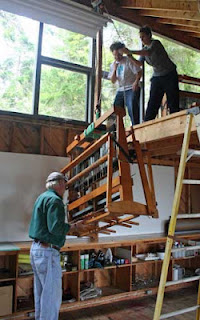 |
| The rocky coast of Deer Isle Maine |
 |
| Lesley scrapes off masking tape. |
In late May I went up to
Haystack Mt. School of Crafts to volunteer for their annual spring clean up and studio maintenance. I was happily assigned to the Textile studio. When I was asked if I would mind going through the looms and see what needed repairs, I replied "Are you kidding?" I jumped right in and was even given a few comrades to help with the moving and cleaning of the looms.
Now mind you, these loom see far less action than they did when I first attended Haystack in the 1970s. The Textile studio now is used for all sorts of surface design and textile arts. So these looms get used maybe once a season. And over the years they have been rather neglected. As with many communal studio spaces the equipment does not get the TLC one would give their own loom. So these looms had YEARS of crusty masking tape gummed up all over them. That was our first task, to remove the tape.
We discovered that Silicone spray on the old tape would work really well to help loosen up the stuff. Then using a scraper we could usually easily remove most of the old tape.
Please remember to REMOVE all the tape whenever you put it on your loom!! Your loom will love you back for this effort.
 |
| Silicone spray helps loosen old tape |
 |
| Many hands make light work, thanks team! |
|
 |
| Hoisting the looms down from the loft |
Over the period of two days we scraped and cleaned, washed and dusted over 15 Macomber Looms. A few years back Haystack Mt. School made the wise decision to convert the weaving equipment to all one loom brand. This makes it easier to teach weaving and maintain the equipment. So with the help of a few of wonderful friends, we made light work of a long over due task.
Now because the Textile studio is used for many other techniques besides weaving, about ten of the looms are stored in a loft. Here's how we got them up and down! No easy task!
 |
| Misty evening on Haystack shores. |
 |
| Yes, the color of the water is really this green! |
Next week, I will head back up to Deer Isle to bring the parts that many of these looms need to be brought up to working order, including ten beams that needed new aprons strings! My dear husband Ben and I will spend another two days working to install beams and other parts. I look forward to breathing in the salty air and resting awhile down on the granite shores.
 |
| Sarah at Sunapee NH Crafts fair |
Now most of you know that I have been at this business of weaving for a very long time. So when I was at the Macomber shop last week, the guys handed me this photo, taken in 1983(?). I hope you get a good laugh at the glasses, hair and the skirt. I know I did! Here also is the first page of an article written about that photo. A healthy sense of humor about one's self is very important as we travel along this road of life!
 |
| Computing Magazine article |
On a final note, I get many calls from people that are re-habbing old Macomber Looms. Most folks want the short cut version of what to do. So here you go:
MACOMBER LOOM REHAB AND BASIC MAINTENANCE LIST:
- Clean all the wood with Murphy's Oil soap
- If any of the wood is "raw" apply a light urethane to seal it
- Vaseline all connections between bronze and steel (jacks, etc)
- Spray metal parts with silicone spray (Heddle bars, etc) (NEVER use WD30 or 3 in 1 oil!!)
- Spray lamms and guides with silicone spray
- If cast iron parts are rusty, use Rustoleum paint
That's the important stuff. Thanks to everyone for your comments and photos of your looms. Happy weaving!













